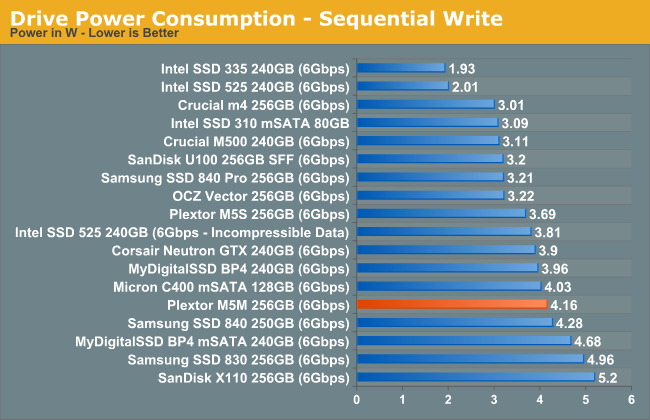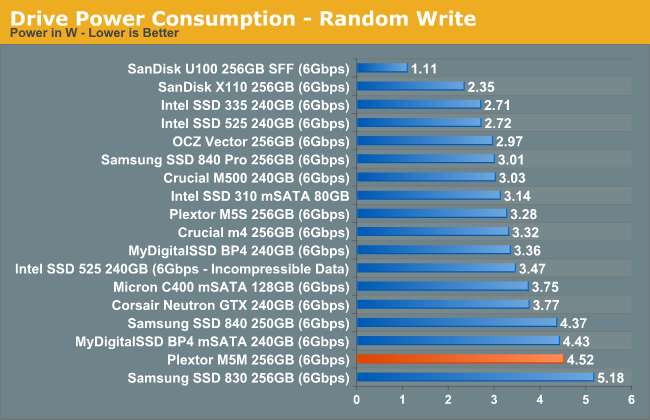Plextor M5M (256GB) mSATA Review
by Kristian Vättö on April 17, 2013 10:20 AM ESTPower Consumption
One of the key elements of Haswell will be up to 10 days of connected standby. To enable that, Serial ATA organization came up with a new SATA specification: DEVSLP (stands for Device Sleep). It's just an addition to the existing SATA 6Gbps standard but to function it needs chipset and device level support. Haswell is the first platform to support DEVSLP but Plextor was forward thinking and the M5M already supports it.
The idea behind DEVSLP is that the drive can enter very low-power state and then resume from that state very quickly. For example, if an email comes in, the drive can't spend seconds powering itself up because that's wasted battery charge -- it needs to be functioning in a matter of milliseconds and then go back to low-power state once the task has been completed. Plextor is claiming that the M5M can resume from DEVSLP mode in only 100ms and while in DEVSLP, it will only draw 1mW of power.
Our platform obviously doesn't support DEVSLP (yet), so we can't test this in action. Also, as someone noted in our MyDigitalSSD mSATA SSD review, the mSATA spec is actually rated at 3.3V, while our results are based on measuring the current from the 5V rail that comes from the power supply. We don't have any equipment to measure the current at the 3.3V rail (there's a voltage regulator in the adapter that lowers the voltage), hence we have to measure the power consumed by both, the drive and the adapter. I have no idea how much power the voltage regulator is drawing (I know the model and have the datasheet, so if anyone knows how to calculate the power, let me know) and some of the results here does seem pretty high. However, I doubt the M5M is drawing significantly more power than the M5 Pro given that they share the same components, so using the M5 Pro as a reference point is not a bad idea.













36 Comments
View All Comments
JellyRoll - Thursday, April 18, 2013 - link
The consistency testing and all trace based testing used by this site are tested without partitions or filesystems, and no TRIM functionality. This has been disclosed by the staff in the comment sections of previous reviews.bobsmith1492 - Wednesday, April 17, 2013 - link
Hi Kristian,Let me know the regulator part number and I can calculate the loss in the regulator. The main difference is if it is a switching or linear part. A linear part will waste 100% * (5-3.3)/5 percent of the power, or 34% neglecting the usually small quiescent current. A switcher will waste less, usually 10-20%.
Kristian Vättö - Wednesday, April 17, 2013 - link
It's Micrel 29150 as far as I know. Here's the datasheet http://www.micrel.com/_PDF/mic29150.pdfAshaw - Wednesday, April 17, 2013 - link
That is a linear part. Current in = current out + the ground pin current. See the graph on page 10. The ground current is about 1/50 the output current in this part. so the input current is a good approximation of the output current.Ashaw - Wednesday, April 17, 2013 - link
So the powers in the graphs above should be approx 0.41W, 2.75W and 2.98 W respectively. (Maybe slightly less in le lower digit if I were to include regulator losses).bobsmith1492 - Wednesday, April 17, 2013 - link
Agreed, the SSD is using approximately 66% of the measured power on the 5V rail.JellyRoll - Wednesday, April 17, 2013 - link
There are two problems with this statement:"In our Intel SSD DC S3700 review Anand introduced a new method of characterizing performance: looking at the latency of individual operations over time."
1. Anand did not introduce this testing, another website did.
2. it isnt looking at individual operations, thousands of operations are happening per second, hence the term 'IOPS' (I/O Per Second)
JellyRoll - Wednesday, April 17, 2013 - link
Actually there is a third problem with the statement, it isnt looking at latency either. It is looking at IOPS, which is much different than latency. There are no latency numbers in this test.JPForums - Thursday, April 18, 2013 - link
There are no latency numbers displayed directly in the results, but latencies are implicit in the IOPS measurement. You may not be getting individual operation latencies, but IOPS is the inverse of average operation latency. So Just divide 1 by the number IOPS and you'll get your average operation latency.In general, I give reviewers the benefit of the doubt and try to put aside small slip ups in nomenclature or semantics as long as it is relatively easy to understand the points they are trying to make. That said, you seem to have it out for Kristian (or perhaps Anandtech as a whole), giving no slack and even reading things into statements that I'm not sure are there. I have no vested interest in Anandtech beyond the interest of reading good reviews, but I have to ask, did Kristian kick your dog or something? I'm honestly interested if you have a legitimate grievance.
JellyRoll - Thursday, April 18, 2013 - link
Pointing out numerous problems with methodology is simply that, in particular the consistency tests are wildly misleading for a number of reasons, the least of which is an unreal workload. I will not resort to replying to thinly veiled flamebait attempts.